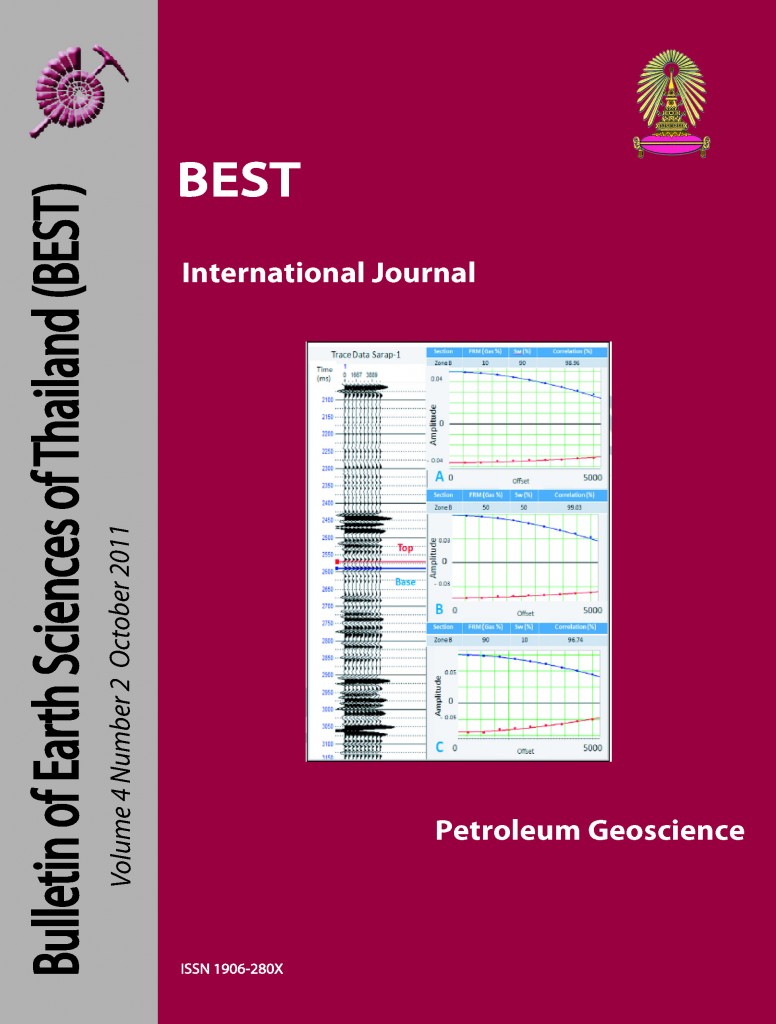Structural Development of Thrusts, Folds and Fractures in Quarry Exposures of Permian Limestones, Saraburi Province, Central Thailand: Implication for Fracture Reservior Development in NE Thailand
Main Article Content
Abstract
Exposures in two quarries (quarry-1 and 2), Saraburi Province, central Thailand reveal that Permian Limestone folds and thrusts underwent complex deformation related to the Indosinian Orogeny (Late Permian to Early Triassic). Possibly the structural grain was reactivated during Cenozoic time. The deformation history evidenced by outcrop patterns in the study area evolved largely under the influence of (approximately) N – S directed compression. The two largest thrust faults in the study area trend ~ E – W, and dip 35° – 40°. Disharmonic buckle folds, fault – bend fold and detachment fold are present with the main fold axes trending approximately E – W.Two types of fractures are present: unfilled and calcite-filled fractures. Fracture sets can be grouped into two main categories: a) Bedding-orthogonal fractures with consistent trends (longitudinal fractures with E – W trend, transverse fractures with N – S trend and diagonal fractures with NE – SW and NW - SE trends) and, b) Non-orthogonal fractures with bedding showing discrete and isotropic orientations. These fractures tended to progressively develop during folding and thrusting in the core zone of deformation. The high-angle fractures in the fault zone are truncated by a late stage sub-horizontal pressure solution cleavage, which probably developed during loading by a now eroded higher thrust sheet. Stable oxygen and carbon isotope signatures in calcite veins indicate that they are related to tectonism. The calcite veins (Group I),are parallel to thrusting and formed during bedding plane slip, veins precipitated under the influence of fluid circulating through, and released from, the host rock during burial. In contrast, calcite veins of Group II, are present perpendicular andto, or high angles to bedding, they formed from even higher temperature fluids flowing along fractures. All this evidence indicates synchronous calcite growth is related to thrusting. The larger thrust faults appear to have been the focus for the migration of hotter, deeper basinal fluids. Moreover, ferroan-rim calcites in veins indicate late stage precipitation from hot fluids, related to deep burial reducing conditions, with iron probably derived from clay minerals within the carbonates. The fractured Permian reservoirs of the Sin Phu Horm and Nam Phong gas fields in NE Thailand, to the north of the study area in the Khorat Plateau, have proven difficult to understand and predict in term of their reservoir properties. Therefore, the results of this outcrop study are directly applicable to the fractured carbonate reservoirs of this region and elsewhere in SE Asia.
Article Details

This work is licensed under a Creative Commons Attribution-NonCommercial-NoDerivatives 4.0 International License.
Copyright © 2008 Department of Geology, Faculty of Science, Chulalongkorn University. Parts of an article can be photocopied or reproduced without prior written permission from the author(s), but due acknowledgments should be stated or cited accordingly.
References
Dunham, R. J.,1962, Classification of carbonate rocks according to depositional texture. In Ham, W. E. Classification of carbonate rocks: American Association of Petroleum Geologists Memoir. 1. p. 108121.
Hinthong, C., S. Chuaviroj, W. Kaewyana, S. Srisukh, C. Pholprasit, and S. Pholachan, 1985, Geological map of Thailand on 1:250,000 scale: Sheet Changwat Pra Nakhon Si Ayutthaya (ND 47-8), in D. M. R. Geological Survey Division, ed., Bangkok.
Nelson, R. A., 2001, Geologic Analysis of Naturally Fractured Reservoirs (Secondedition): Woburn, Gulf Professional Publishing, 332 p.
Thambunya, S., V. Pisutha-Arnond, and C. Khantaprab, 2007, Depositional Environments of Permian Rocks of The Khao Khad Formation in Central Thailand: Science Asia, v. 33, p. 371-381.


